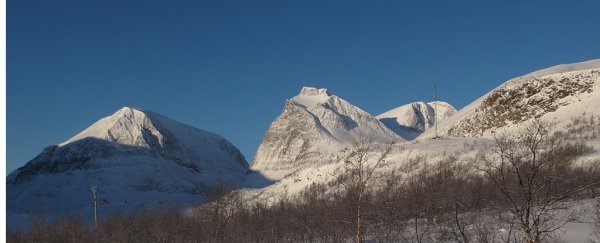It's not as if the world needed another symbol for the climate crisis, but now Sweden has one all to itself. After years of rising temperatures and back-to-back summer heatwaves, the southern peak of Kebnekaise, Sweden's former tallest mountain, has melted into subservience.
For decades, the glacier atop this iconic summit has been in retreat, and now measurements show it has been dethroned as the nation's tallest point. It's neighbour, the ice-free northern peak, now reigns victorious.
"This is the lowest height ever measured," says Gunhild Ninis Rosqvist, a geographer who focuses on changing polar environments at Stockholm University.
"Over the past 50 years, the height of Kebnekaise's southern peak has decreased by 24 metres."
And recently, things have only been getting worse. In the past decade alone, the melt rate has been roughly one metre per year.
The southern peak's fall from grace has been coming for a while now. Just last year, the northern peak came neck-and-neck with the southern peak and researchers suspected that it might have even slipped past, although measurements were not accurate enough to say for sure.
This year, the measurements were more exact. At the end of this summer, researchers at Stockholm University announced that the southern peak was, in fact, 1.2 metres (4 feet) shorter than the northern peak. Currently, it stands at just 2,095.6 metres (around 6,875 feet).
The height of this glacier fluctuates by about three metres between summer and winter, and September is when it's at its lowest. Over the winter, it's likely to gather more height by building up a nice pack of snow and ice, but the overall trajectory is unmistakable. The melting rate has only increased in recent years and it shows no signs of slowing down.
Sitting just north of the Arctic circle, Kebnekaise lies in a region that's warming twice as fast as the rest of the world. This year, huge swathes of Greenland, Siberia and Alaska were ravaged by wildfires. In July, a village in the far north of Sweden experienced the highest temperatures ever recorded above the Arctic circle.
Such unprecedented events are not normal. Scientists have calculated that the record-breaking heatwaves in Europe this year were made at least 5 and possibly 100 times more likely by climate change.
In the end, Sweden's southern peak is just another magnificent glacier toppled by a rapidly changing climate, and, as always, an ominous sign of what we've done to our planet.
"I just had a colleague who hasn't been here for 10 years and he was in shock," Rosqvist told CNN.
"The rate is faster than I anticipated. Maybe we don't need so many symbols because we know that it's getting warmer. But maybe this will help people realise that we need to do something about it."
